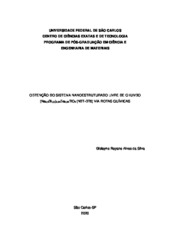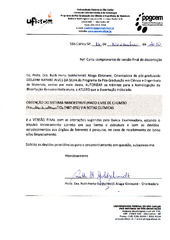| dc.contributor.author | Silva, Gislayne Rayane Alves da | |
| dc.date.accessioned | 2021-06-30T11:36:11Z | |
| dc.date.available | 2021-06-30T11:36:11Z | |
| dc.date.issued | 2020-09-16 | |
| dc.identifier.citation | SILVA, Gislayne Rayane Alves da. Obtenção do sistema nanoestruturado livre de chumbo (Na0,5Bi0,5)0,94Ba0,06TiO3 (NBT-BT6) via rotas químicas. 2020. Dissertação (Mestrado em Ciência e Engenharia de Materiais) – Universidade Federal de São Carlos, São Carlos, 2020. Disponível em: https://repositorio.ufscar.br/handle/ufscar/14471. | * |
| dc.identifier.uri | https://repositorio.ufscar.br/handle/ufscar/14471 | |
| dc.description.abstract | Perovskites based on sodium bismuth titanate (Na0.5Bi0.5TiO3) are
promising candidates for replacing some ceramic materials based on lead due
to piezoelectric properties. The solid solution 0.94(Na0.5Bi0.5)TiO3-0.06BaTiO3
(NBT-BT6) can be highlighted as it shows the morphotropic phase boundary in
this composition, where its dielectric and ferroelectric properties are maximized,
as well as the piezoelectric coefficient. Most studies report the solid-state reaction
as a method of obtaining this nanostructured system, which compromises its
stoichiometry. Thus, this dissertation aims at the study the achievement of the
NBT-BT6 through conventional hydrothermal synthesis and microwave-assisted
routes and polymeric precursor - Pechini. In the hydrothermal synthesis, the
study of the variation of the mineralizing concentration , time and temperature
was carried out, whereas in the polymeric precursor - Pechini method, the
temperature of the heat treatment of the dehydrated resin was the analyzed
variable. In powders obtained under hydrothermal conditions, both conventionally
and assisted by microwaves, the presence of the NBT and BT phases, and the
anatase and brookite phases, after synthesis, were identified. Particles in cubic
shapes and fibers were formed in both synthesis methods. The powders obtained
via microwave-assisted hydrothermal route showed particles with a smaller
average size and morphology with a greater presence of fibers, obtained in only
4% of the synthesis time, and after sintering at 900 °C for 2 hours they presented
the NBT- BT6 phase and relative density of 87%. In samples synthesized by the
polymeric precursor -Pechini method, the NBT-BT6 phase without secondary
phases was obtained at 650 °C. In addition, the transformation of the phase at
260 °C, from rhombohedral to tetragonal, was observed for the formation of the
solid solution NBT-BT6 indicating the presence of the morphotropic phase
boundary and the beginning of crystallization at 450 °C, the lowest temperature
reported in the literature. | eng |
| dc.description.sponsorship | Conselho Nacional de Desenvolvimento Científico e Tecnológico (CNPq) | por |
| dc.language.iso | por | por |
| dc.publisher | Universidade Federal de São Carlos | por |
| dc.rights | Attribution-NonCommercial-NoDerivs 3.0 Brazil | * |
| dc.rights.uri | http://creativecommons.org/licenses/by-nc-nd/3.0/br/ | * |
| dc.subject | Síntese | por |
| dc.subject | Hidrotermal micro-ondas | por |
| dc.subject | Precursor polimérico - Pechini | por |
| dc.subject | Hidrotermal convencional | por |
| dc.subject | NBT-BT6 | por |
| dc.subject | Synthesis | eng |
| dc.subject | Microwave hydrothermal | eng |
| dc.subject | Polymeric precursor | eng |
| dc.subject | Conventional hydrothermal | eng |
| dc.title | Obtenção do sistema nanoestruturado livre de chumbo (Na0,5Bi0,5)0,94Ba0,06TiO3 (NBT-BT6) via rotas químicas | por |
| dc.title.alternative | Achievement of the nanostructured lead-free system (Na0.5Bi0.5)0.94Ba0.06TiO3 (NBT-BT6) by chemical routes | eng |
| dc.type | Dissertação | por |
| dc.contributor.advisor1 | Kiminami, Ruth Herta Goldschmidt Aliaga | |
| dc.contributor.advisor1Lattes | http://lattes.cnpq.br/7643216999108223 | por |
| dc.contributor.advisor-co1 | Perdomo, Claudia Patricia Fernández | |
| dc.contributor.advisor-co1Lattes | http://lattes.cnpq.br/0062895903351287 | por |
| dc.description.resumo | Perovskitas a base de titanato de bismuto sódio (Na0,5Bi0,5TiO3) são
candidatas promissoras à substituição de alguns materiais cerâmicos à base de
chumbo, devido às propriedades piezoelétricas. A obtenção da solução sólida
0,94(Na0,5Bi0,5)TiO3-0,06BaTiO3 (NBT-BT6) vem se destacando por exibir, nessa
composição, o contorno de fase morfotrópico, na qual suas propriedades
dielétricas e ferroelétricas são maximizadas, bem como o coeficiente
piezoelétrico. A maioria dos estudos reportam a reação no estado sólido como
um método viável de se obter o NBT-BT6, porém, com estequiometria
comprometida. Assim, esta dissertação teve como objetivo o estudo da obtenção
do NBT-BT6 por meio das rotas de síntese hidrotermal convencional e assistida
por micro-ondas e precursor polimérico - Pechini. Na síntese hidrotermal, foi
realizado o estudo da variação de concentração do mineralizante, tempo e
temperatura, enquanto que no método do precursor polimérico, Pechini, a
temperatura de tratamento térmico da resina desidratada foi a variável analisada.
Nos pós obtidos sob condições hidrotermais, tanto convencionalmente como
assistido por micro-ondas, foram identificadas a presença das fases NBT e BT e
as fases anatase e broquita, após a síntese. Partículas em formatos cúbicos e
fibras foram formadas em ambos os métodos de síntese. Os pós obtidos via rota
hidrotermal assistida por micro-ondas apresentaram partículas com menor
tamanho médio e morfologia com maior presença de fibras, obtidos em apenas
4% do tempo de síntese. Após sinterização a 900 °C, durante 2 horas,
apresentaram a fase NBT-BT6 e densidade relativa de 87%. Nas amostras
sintetizadas pelo método do precursor polimérico, Pechini, a fase NBT-BT6, sem
fases secundárias, foi obtida a 650 °C. Além disso, constatou-se a transformação
de fase em 260 °C de romboédrica para a tetragonal para a formação da solução
sólida NBT-BT6, indicando a presença do contorno de fase morfotrópico, e início
de cristalização a 450°C, menor temperatura reportada na literatura. | por |
| dc.publisher.initials | UFSCar | por |
| dc.publisher.program | Programa de Pós-Graduação em Ciência e Engenharia de Materiais - PPGCEM | por |
| dc.subject.cnpq | ENGENHARIAS::ENGENHARIA DE MATERIAIS E METALURGICA::MATERIAIS NAO METALICOS | por |
| dc.description.sponsorshipId | CNPq: 158534/2018-2 | por |
| dc.publisher.address | Câmpus São Carlos | por |
| dc.contributor.authorlattes | http://lattes.cnpq.br/5322024584470497 | por |


